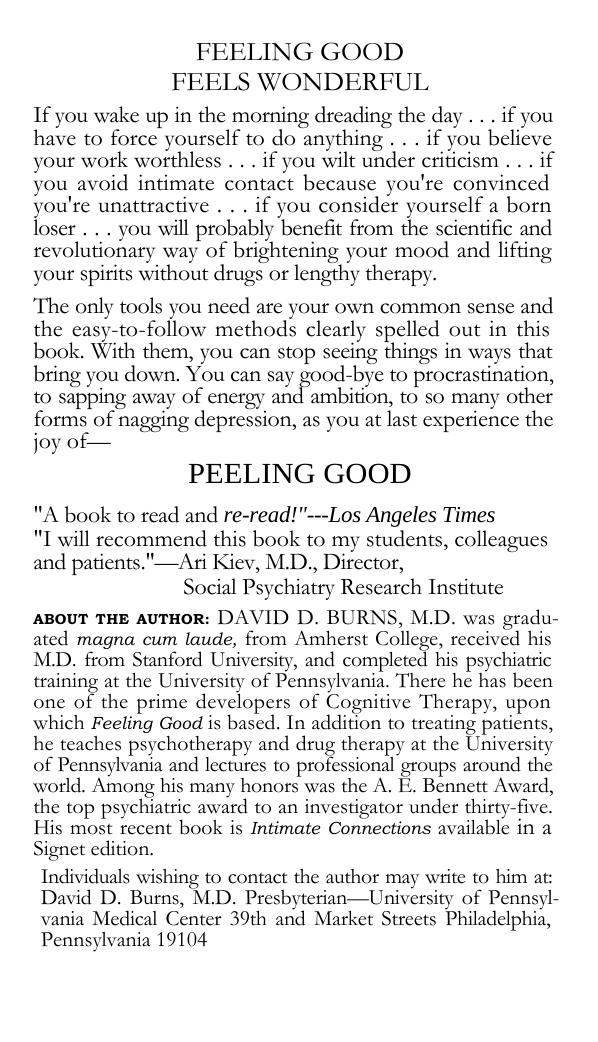Feeling Good: The New Mood Therapy by David D. Burns

Author:David D. Burns [Burns, David D.]
Language: eng
Format: mobi, pdf
Publisher: Harper
Published: 2012-11-20T08:00:00+00:00
* * *
Let’s take a simple example. Suppose you are in the habit of double-checking the house or car locks several times. Certainly it’s okay to check things once, but more often than that is redundant and pointless. Drive your car to a parking lot, lock the doors, and walk away. Now—refuse to check them! You will feel uneasy. You’ll try to persuade yourself to go back and “just make sure.” DON’T. Instead, record your degree of anxiety every minute on the “Response-Prevention Form” (see Figure 14–3) until the anxiety has vanished. At this point, you win. Often, one such exposure is sufficient to break a habit permanently, or you may need numerous exposures as well as a booster shot from time to time. Many bad habits lend themselves to this format, including various “checking rituals” (checking to see if the stove is turned off or if the mail has fallen into the mailbox, etc.), cleaning rituals (compulsive handwashing or excessive housecleaning), and others. If you are ready and willing to break free of these tendencies, I think you’ll find the response-prevention technique quite helpful.
6. You may be asking yourself about the origin of the crazy fear that drives you to compulsive perfectionizing. You can use the vertical-arrow method described in Chapter 10 to expose the silent assumption that causes your rigid, tense approach to living. Fred is a college student who was so preoccupied with getting a term paper “just right” that he dropped out of college to work on it for an entire year to avoid the horrors of turning in a product he wasn’t entirely satisfied with. Fred finally enrolled in college again when he felt ready to turn the paper in, but sought treatment for his perfectionism because he realized it might take too long to complete college this way!
He had his confrontation with fear when he was required to turn in another term paper at the end of his first semester back in school. This time the professor gave him the ultimatum of either turning it in by six P.M. on the due date, or getting docked one full grade for every day it was late. Since Fred had an adequate draft of the paper, he realized it wouldn’t be wise for him to try to polish it and revise it, so he reluctantly turned it in at 4:55, knowing that there were a number of uncorrected typographical errors as well as some sections he wasn’t entirely satisfied with. The moment he turned it in, his anxiety began to mount. Minute by minute it increased, and soon Fred was gripped by such a severe panic attack that he called me at home late in the evening. He was convinced that something terrible was about to happen to him because he had turned in an imperfect paper.
I suggested he use the vertical-arrow method to pinpoint just what he was so afraid of. His first automatic thought was, “I didn’t do an excellent job on the paper.”
Download
Feeling Good: The New Mood Therapy by David D. Burns.pdf
This site does not store any files on its server. We only index and link to content provided by other sites. Please contact the content providers to delete copyright contents if any and email us, we'll remove relevant links or contents immediately.
Should I Stay or Should I Go? by Ramani Durvasula(6784)
Why We Sleep: Unlocking the Power of Sleep and Dreams by Matthew Walker(5641)
Fear by Osho(4085)
Flow by Mihaly Csikszentmihalyi(4052)
Rising Strong by Brene Brown(3780)
Why We Sleep by Matthew Walker(3771)
Too Much and Not the Mood by Durga Chew-Bose(3693)
How to Change Your Mind by Michael Pollan(3676)
The Hacking of the American Mind by Robert H. Lustig(3579)
Lost Connections by Johann Hari(3455)
He's Just Not That Into You by Greg Behrendt & Liz Tuccillo(3300)
Evolve Your Brain by Joe Dispenza(3050)
What If This Were Enough? by Heather Havrilesky(2945)
Resisting Happiness by Matthew Kelly(2886)
Crazy Is My Superpower by A.J. Mendez Brooks(2860)
The Courage to Be Disliked by Ichiro Kishimi & Fumitake Koga(2796)
The Book of Human Emotions by Tiffany Watt Smith(2770)
Descartes' Error by Antonio Damasio(2731)
In Cold Blood by Truman Capote(2684)
